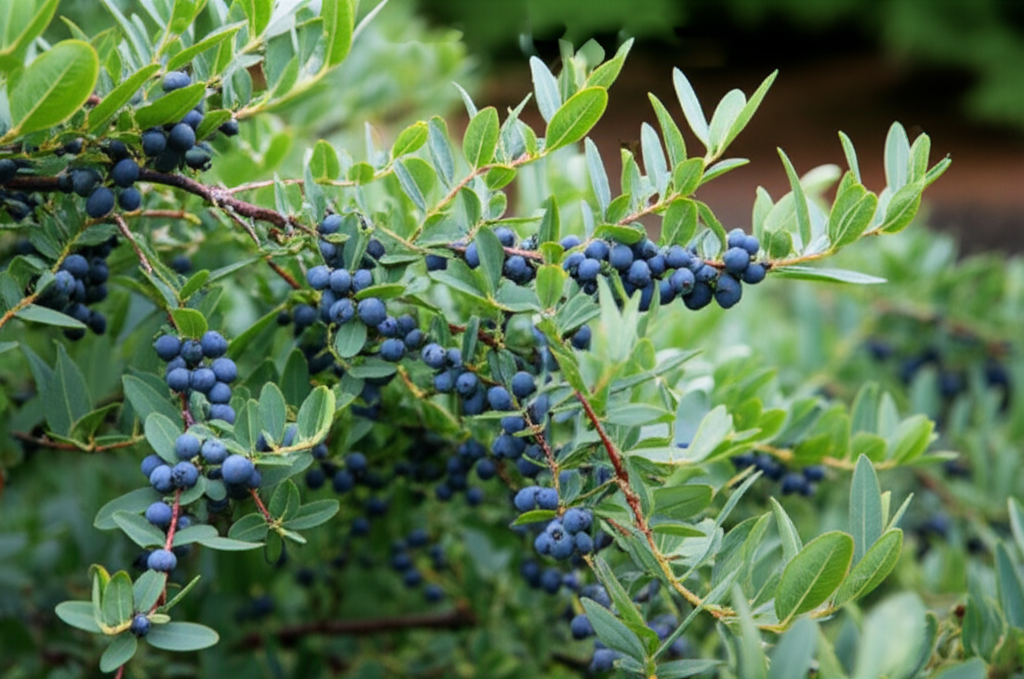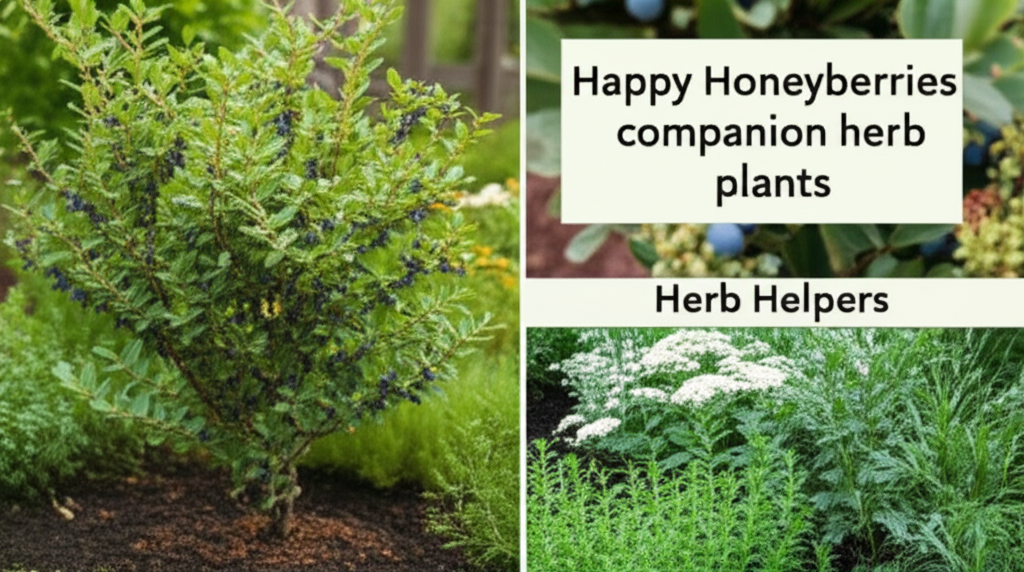Unlocking the Full Potential of Your Honeyberry Bushes with Companion Planting
Honeyberries (Lonicera caerulea), also known as Haskaps, are gaining immense popularity among home gardeners for their delicious, antioxidant-rich berries and their remarkable hardiness. These early-blooming shrubs are a welcome sight in spring, providing a harvest even before strawberries ripen. However, like any plant, honeyberries can benefit from strategic partnerships in the garden. Companion planting, the practice of growing different plants together for mutual benefit, can significantly enhance the health, productivity, and pest resistance of your honeyberry bushes.
This comprehensive guide explores the synergistic relationships between honeyberry shrubs and a variety of herb plants. By understanding which herbs can act as beneficial allies, you can create a thriving ecosystem in your garden that supports vigorous growth, deters pests, attracts pollinators, and ultimately leads to a more abundant and flavorful honeyberry harvest.
The Science Behind Companion Planting for Honeyberries

Companion planting isn’t just folklore; it’s rooted in ecological principles. Certain plants can deter pests, attract beneficial insects, improve soil health, or even enhance the flavor of neighboring crops. For honeyberries, specific herbs offer a range of advantages:
- Pest Deterrence: Many herbs possess strong scents that can mask the aroma of honeyberry bushes, confusing pests that rely on scent to locate their hosts.
- Attracting Beneficial Insects: Herbs that produce nectar and pollen, especially those with small flowers, are magnets for predatory insects and parasitoids that feed on common honeyberry pests like aphids and certain caterpillars.
- Improving Soil Health: Some herbs have deep taproots that can break up compacted soil, improve drainage, and cycle nutrients, making them more accessible to the honeyberry roots.
- Repelling Weeds: Ground-covering herbs can help suppress weed growth, reducing competition for water and nutrients.
- Attracting Pollinators: While honeyberries are self-pollinating, cross-pollination often leads to larger and more abundant fruit. Attracting a diverse range of pollinators to your garden can enhance this process.
Top Herb Companions for Your Honeyberry Bushes
Selecting the right herb companions is crucial. The goal is to choose herbs that provide benefits without competing aggressively for resources like sunlight, water, or nutrients. Here are some of the most effective herb allies for honeyberry shrubs:
1. Mint Family (Lamiaceae)
Herbs from the mint family are renowned for their potent aromas and their ability to deter various pests. However, it’s essential to manage their vigorous growth.
- Peppermint (Mentha piperita): Its strong scent can deter aphids, ants, and flea beetles.
- Spearmint (Mentha spicata): Similar to peppermint, it repels aphids and other common garden pests.
- Lemon Balm (Melissa officinalis): This member of the mint family is excellent at attracting pollinators like bees and can also deter some flying insects.
Consideration: Due to their invasive nature, it is highly recommended to plant mints in containers or with root barriers to prevent them from spreading and overwhelming your honeyberry bushes.
2. Lavender (Lavandula spp.)
Lavender is a gardener’s favorite for its beautiful blooms, soothing fragrance, and its ability to attract beneficial insects.
- Pest Deterrence: The strong scent of lavender is known to repel moths, mosquitoes, and even deer.
- Beneficial Insect Attraction: Lavender flowers are a prime source of nectar for bees, butterflies, and other pollinators.
- Soil Improvement: Lavender prefers well-drained soil, which also benefits honeyberries.
Planting Tip: Plant lavender a reasonable distance from the base of your honeyberry bushes to ensure adequate airflow and sunlight for both plants.
3. Rosemary (Salvia rosmarinus)
Rosemary is a hardy, drought-tolerant herb that thrives in similar conditions to honeyberries (well-drained soil and plenty of sun).
- Pest Repellent: Its pungent aroma can deter cabbage moths, carrot rust flies, and bean beetles, which can indirectly benefit surrounding plants.
- Beneficial Insect Habitat: Rosemary flowers attract bees and other pollinators.
- Aromatic Companion: The strong scent can mask the odor of honeyberry bushes, confusing pests.
Note: Rosemary is a perennial in warmer climates and can be grown as an annual in colder regions.
4. Thyme (Thymus spp.)
Thyme is a low-growing, creeping herb that can act as a living mulch, suppressing weeds and retaining soil moisture.
- Pest Control: Thyme is effective at repelling cabbage worms, cabbage moths, and tomato hornworms.
- Attracting Beneficials: Its small flowers are highly attractive to bees and other pollinators.
- Soil Health: Creeping thyme varieties can help prevent soil erosion and improve soil structure.
Planting Suggestion: Plant creeping thyme varieties around the drip line of your honeyberry bushes.
5. Sage (Salvia officinalis)
Sage is a versatile herb known for its medicinal properties and its ability to deter pests.
- Pest Deterrence: Sage is effective against cabbage moths, carrot flies, and flea beetles. It’s also said to deter wasps and flies.
- Beneficial Insect Attractor: Sage flowers attract bees and butterflies.
- Companion for Soil: Sage can help improve the health of sandy soils.
Key Benefit: The strong, aromatic foliage of sage is particularly good at masking the scent of honeyberry bushes from pests.
6. Oregano (Origanum vulgare)
Oregano is a hardy, low-maintenance herb that offers a multitude of benefits to the garden.
- Pest Repellent: Its strong scent repels many common garden pests, including aphids, spider mites, and whiteflies.
- Beneficial Insect Habitat: The small flowers of oregano are a great food source for bees and other beneficial insects.
- Ground Cover: Spreading oregano can help suppress weeds and retain soil moisture.
7. Borage (Borago officinalis)
Borage is a fast-growing annual herb with beautiful star-shaped blue flowers. It’s a superb companion plant for a variety of reasons.
- Pollinator Magnet: Borage is an exceptionally strong attractant for bees and other pollinators, which can boost honeyberry fruit set.
- Pest Deterrent: Its hairy leaves are thought to deter certain pests like tomato hornworms and slugs.
- Dynamic Accumulator: Borage is known to accumulate minerals like potassium and calcium from deeper soil layers, making them available to neighboring plants when its leaves decompose.
Sowing Tip: Sow borage seeds directly in the garden after the last frost. It readily self-seeds, so you’ll likely have it for years to come.
8. Dill (Anethum graveolens)
Dill is a delicate yet powerful herb in the companion planting world.
- Beneficial Insect Attractor: Dill flowers attract hoverflies, ladybugs, lacewings, and parasitic wasps, all of which are voracious predators of aphids and other common honeyberry pests.
- Pest Repellent: Its strong scent can confuse pests like spider mites and aphids.
- Edible Harvest: You also get the added benefit of fresh dill for your culinary uses.
Planting Advice: Avoid planting dill too close to carrots, as they can cross-pollinate. However, this is not an issue with honeyberry bushes.
Key Facts and Comparisons of Herb Companions
Here’s a table summarizing the primary benefits of each recommended herb companion for your honeyberry shrubs:
| Herb | Primary Benefit for Honeyberry | Key Pests Repelled | Attracts | Growth Habit |
|---|---|---|---|---|
| Mint (Peppermint, Spearmint) | Pest Deterrence (strong scent) | Aphids, Ants, Flea Beetles | Pollinators (Lemon Balm) | Vigorous spreader (container recommended) |
| Lavender | Pollinator Attraction, Pest Repellent | Moths, Mosquitoes, Deer | Bees, Butterflies | Bushy, upright |
| Rosemary | Pest Repellent, Pollinator Attraction | Cabbage Moths, Carrot Rust Flies | Bees | Bushy, upright |
| Thyme | Weed Suppression, Pollinator Attraction | Cabbage Worms, Cabbage Moths | Bees | Low-growing, creeping |
| Sage | Pest Deterrence, Soil Improvement | Cabbage Moths, Carrot Flies | Bees, Butterflies | Bushy, upright |
| Oregano | Pest Repellent, Weed Suppression | Aphids, Spider Mites | Bees | Low-growing, spreading |
| Borage | Pollinator Magnet, Soil Improvement | Slugs, Hornworms (potential) | Bees (excellent), Butterflies | Erect, self-seeding annual |
| Dill | Beneficial Insect Attractor | Spider Mites, Aphids (indirectly) | Hoverflies, Ladybugs, Lacewings | Feathery, upright annual |
Implementing Companion Planting with Honeyberries: Practical Steps and Considerations
Successfully integrating herb companions with your honeyberry bushes involves careful planning and execution. Consider the growth habits of both the herbs and the honeyberries, as well as their specific needs.
Step-by-Step Guide to Companion Planting
- Assess Your Garden Space: Determine the sunlight, soil, and drainage conditions in the area where your honeyberry bushes are planted.
- Choose Your Herbs: Select herbs that thrive in similar conditions and offer the most benefit to your honeyberry plants based on your specific pest pressures or desired outcomes (e.g., attracting more pollinators).
- Plan Your Layout: Position herbs strategically. For spreading herbs like mint or oregano, consider planting them in containers or using root barriers. For taller herbs like dill or borage, plant them where they won’t shade the honeyberry bushes too much.
- Prepare the Soil: Ensure the soil is well-draining, which is crucial for both honeyberries and many of these herbs. Amend the soil with compost if necessary.
- Planting: Plant your chosen herb seedlings or seeds around the base of the honeyberry bushes, typically at a distance of 6-12 inches from the main stem to avoid root competition.
- Watering and Maintenance: Water newly planted herbs regularly until established. Continue to monitor soil moisture for both the honeyberries and their companions. Prune herbs as needed to maintain their shape and prevent them from becoming too dominant.
Pros and Cons of Herb Companions for Honeyberries
While the benefits of companion planting are numerous, it’s important to be aware of potential drawbacks and manage them effectively.
| Pros | Cons |
|---|---|
| Enhanced pest resistance through natural repellents. | Risk of invasive herbs (e.g., mint) outcompeting honeyberries if not managed. |
| Increased attraction of beneficial insects that prey on pests. | Some herbs may compete for water and nutrients if planted too closely. |
| Improved pollination, leading to potentially larger and more abundant fruit. | Tall herbs can cast shade on honeyberry bushes if not positioned correctly. |
| Suppression of weeds, reducing competition for resources. | Some herbs might have specific soil pH or moisture preferences that differ slightly from honeyberries. |
| Aesthetic appeal and added culinary herbs for your kitchen. | Requires planning and careful placement to maximize benefits and minimize negative impacts. |
| Potential for improved soil health through nutrient cycling (e.g., borage). | Certain herbs might attract pests that, while not directly harmful to honeyberries, could become a nuisance if populations grow unchecked. |
Beyond Herbs: Other Beneficial Companions
While herbs offer fantastic benefits, don’t overlook other plant categories that can complement your honeyberry bushes:
- Alliums (Garlic, Chives): Their strong scent can deter a wide range of pests, including aphids.
- Marigolds (Tagetes spp.): Certain varieties, particularly French marigolds, are known to deter nematodes in the soil.
- Nasturtiums (Tropaeolum majus): These can act as a trap crop for aphids, drawing them away from your honeyberry bushes.
- Legumes (Beans, Peas): They fix nitrogen in the soil, which can be beneficial for nutrient-demanding plants.
Conclusion: Cultivating a Harmonious Honeyberry Ecosystem
By strategically integrating companion herb plants into your honeyberry garden, you’re not just planting more, you’re planting smarter. These aromatic allies can transform your honeyberry patch into a more resilient, productive, and biodiverse haven. From deterring unwelcome pests with their potent fragrances to beckoning beneficial insects with their nectar-rich blooms, herbs play a vital role in fostering a healthy ecosystem around your honeyberry shrubs.
Remember to observe your plants, adapt your strategies as needed, and enjoy the process of creating a thriving, symbiotic garden. With the right herb companions, your honeyberry harvest is sure to be sweeter and more bountiful.


